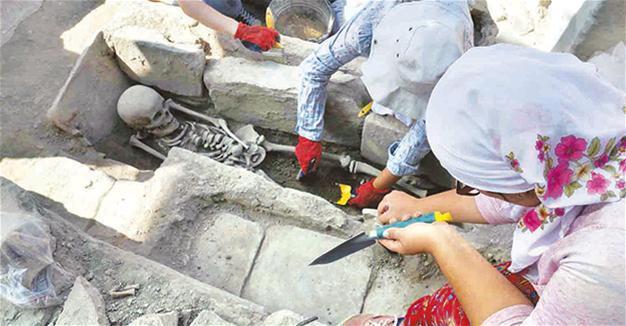Byzantine tombs unearthed in marble city
MUĞLA – Anadolu Agency

AA photo
Some 65 Byzantine-era tombs have been unearthed in the most recent archaeological excavations in the ancient city of Stratonikeia, known as the city of gladiators in the western province of Muğla’s Yatağan district.
“We are continuing works in the graveyard field. Sixty-five Byzantine era tombs were unearthed in the ancient city. The tombs belong to both adults and children,” said the head of the excavations, Pamukkale University Professor Bilal Söğüt.
Teams have uncovered finds related to a settlement from 3,500 years ago, as well as many artifacts from various periods of time, Söğüt said.
He said the ancient city of Stratonikeia, the world’s largest marble city, had retained its importance in the Hellenistic, Roman, Byzantine, Anatolian beylik, Ottoman and Republican eras, adding that it was listed on the UNESCO Tentative List.
Every excavation season in the ancient city has revealed important finds, Söğüt said. “Stratonikeia is a living archaeological city. It is unique. There is no other city in which structures have survived as a whole since ancient ages.”
Byzantine-era tombs were an important part of the ancient city, which had been home to the Carians and the Leleges, said Söğüt.
He said they uncovered finds from the Hellenistic, Roman, early and mid-Byzantine and beylik eras during excavations on the Western Street.
Söğüt said they found a 120-centimeter-long skeleton in a tomb that was recently opened. The skeleton is believed to belong to a young woman who died nearly 1,300 years ago.
He said the tomb was a Byzantine-era structure that had been taken under protection after cleaning works.
Söğüt said historical continuity could be seen in the ancient city and that one of the main streets of the city, called Western Street, was one of those areas.
“In the next process, a church was built here. After the church collapsed, Byzantines used the same field as a graveyard. We cleaned 65 tombs here. We are conserving the finds there and are taking them under protection. Works will continue in 2017, too,” Söğüt said.
Visitors to see it via 3D
Söğüt said the structures unearthed in Stratonikeia would take visitors on a journey in time with 3D technology.
“When the works are done, visitors will be able to see many structures in the ancient city’s center. We revived many spots in the city with 3D technology. Visitors become happy when they see the former situations of the structures; they understand the structures better. We revive the field of the Byzantine era with both gravure drawings and 3D technology. We will show our visitors these fields in the next season,” Söğüt said.
